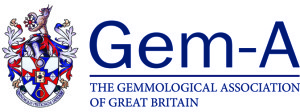London, United Kingdom – August 4, 2014: The Gemmological Association of Great Britain (Gem-A) has
released the latest issue of its academic publication, The Journal of Gemmology, in collaboration with the Swiss Gemmological Institute SSEF and American Gemological Laboratories (AGL). The current issue (Vol. 34, No. 2, 2014), released on 4 August 2014, is packed with a wide variety of new content, covering the latest news and research from the international gemmological community.
This quarter’s issue of The Journal features a diverse line-up of articles, including: a review of the evolution of diamond cuts in Portuguese jewellery and sacred objects during the 16th-18th centuries (by R. Galopim de Carvalho); the presence of beryllium-diffused corundum in the Japanese market and assessing the natural vs. diffused origin of beryllium in sapphire (by K. Emori, H. Kitawaki and M. Okano); the characterization of collectors’ gemstones, including a 100+ ct jeremejevite (by C. P. Smith) and taaffeite from Myanmar (by T. Leelawatanasuk, W. Atichat, Tay Thye Sun, B. Sriprasert and J. Jakkawanvibul); and natural pearls from The Netherlands (by J. C. [Hanco] Zwaan and P. Groenenboom).
The Journal also delves into ‘What’s New’ in the industry by discussing a range of instruments and publications, such as new diamond screening devices; the Sarine Loupe; the latest reports from CIBJO, the Responsible Jewellery Council and gem laboratories; the 2nd edition of The Handbook of Gemmology; and the Help with Hallmarks app. Furthermore, the issue features reports from recent gemmological conferences, as well as detailed listings of upcoming meetings, exhibits and other educational events to further the professional development of its readers.
Other sections that are sure to interest practicing gemmologists include ‘Practical Gemmology’ which documents how a simple polishing technique can result in the misidentification of spinel as more valuable taaffeite or sapphirine, and ‘Gem Notes’ which describes some rare and unusual gemstones seen at the Tucson gem shows, a natural diamond showing a ‘synthetic’ pattern in the DiamondView instrument, a large pastel green sapphire, corundum with coloured lead-glass fillings, and much more.
Discussing the latest issue of The Journal of Gemmology, Editor-in-Chief Brendan Laurs stated: “We are delighted to bring such a diverse line-up of articles to readers of The Journal, ranging from diamonds to collectors’ stones and treated gems to natural pearls. This issue of The Journal is packed with information that every gemmologist can use and contains a vast amount of pioneering gemmological knowledge from around the world.”
All Gem-A members receive hardcopies and online access to quarterly editions The Journal of Gemmology and its sister publication Gems&Jewellery (published 9 times a year), along with a whole host of other features and benefits, for just £125 a year. For more information on how to sign-up and get your copy, visit the Publications section of Gem-A’s website, where you can also sign-up for the Journal‘s mailing list.

